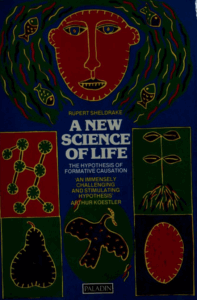Read free. A New Science of Life: The Hypothesis of Formative Causation, by Rupert Sheldrake, 1987.
Excerpt
The hypothesis put forward in this book is based on the idea that morphogenetic fields do indeed have measurable physical effects. It proposes that specific morphogenetic fields are responsible for the characteristic form and organization of systems at all levels of complexity, not only in the realm of biology, but also in the realms of chemistry and physics. These fields order the systems with which they are associated by affecting events which, from an energetic point of view, appear to be indeterminate or probabilistic; they impose patterned restrictions on the energetically possible outcomes of physical processes.
If morphogenetic fields arc responsible for the organization and form of material systems, they must themselves have characteristic structures. So where do these field-structures come from? The answer suggested is that they are derived from the morphogenetic fields associated with previous similar systems: the morphogenetic fields of all past systems become present to any subsequent similar system; the structures of past systems affect subsequent similar systems by a cumulative influence which acts across both space and time.
According to this hypothesis, systems are organized in the way they are because similar systems were organized that way in the past. For example, the molecules of a complex organic chemical crystallize in a characteristic pattern because the same substance crystallized that way before; a plant takes up the form characteristic of its species because past members of the species took up that form; and an animal acts instinctively in a particular manner because similar animals behaved like that previously.
The hypothesis is concerned with the repetition of forms and patterns of organization; the question of the origin of these forms and patterns lies outside its scope. This question can be answered in several different ways, but all of them seem to be equally compatible with the suggested means of repetition.
A number of testable predictions can be deduced from this hypothesis which differ strikingly from those of the conventional mechanistic theory. A single example will suffice: if an animal, say a rat, learns to carry out a new pattern of behaviour, there will be a tendency for any subsequent similar rat (of the same breed, reared under similar conditions, etc.) to learn more quickly to carry out the same pattern of behaviour. The larger the number of rats that learn to perform the task, the easier should it be for any subsequent similar rat to learn it. Thus, for instance, if thousands of rats were trained to perform a new task in a laboratory in London, similar rats should learn to carry out the same task more quickly in laboratories everywhere else. If the speed of learning of rats in another laboratory, say in New York, were to be measured before and after the rats in London were trained, the rats tested on the second occasion should learn more quickly than those tested on the first. The effect should take place in the absence of any known type of physical connection or communication between the two laboratories.
Such a prediction may seem so improbable as to be absurd. Yet, remarkably enough, there is already evidence from laboratory studies of rats that the predicted effect actually occurs.
This hypothesis, called the hypothesis of formative causation, leads to an interpretation of many physical and biological phenomena which is radically different from that of existing theories, and enables a number of well-known problems to be seen in a new light. In the present book, it is sketched out in a preliminary form, some of its implications are discussed, and various ways in which it could be tested are suggested.
Introductory Pages
Related Posts

Man and nature or, Physical geography as modified by human action







